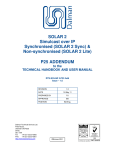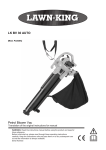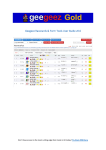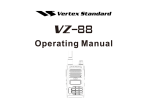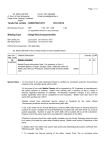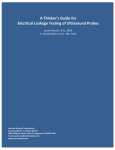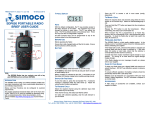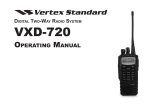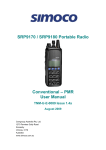Download Product Safety Booklet for Two-way Radio Equipment
Transcript
Product Safety Booklet for Two-way Radio Equipment Document Reference: TNM-SB-E-0001, Issue 1.3 June 2015 IMPORTANT WARNING BEFORE USING THE RADIO EQUIPMENT, READ THIS BOOKLET WHICH CONTAINS IMPORTANT OPERATING INSTRUCTIONS FOR SAFE USAGE AND EQUIPMENT SPECIFIC SAFETY INFORMATION. ADDITIONALLY, THE RF ENERGY AWARENESS AND CONTROL INFORMATION AND OPERATIONAL INSTRUCTIONS FOR COMPLIANCE WITH RF ENERGY EXPOSURE LIMITS IN APPLICABLE NATIONAL AND INTERNATIONAL STANDARDS. SHOULD ALSO BE READ. FOR RADIOS THAT HAVE BEEN APPROVED AS INTRINSICALLY SAFE, READ THE INSTRUCTIONS AND INFORMATION ON INTRINSIC SAFETY. © Simoco 2015 CONTENTS Page RF Energy Exposure Awareness and Control Information and Operational Instructions for Occupational Use ......................................................................................................................... 3 Federal Communication Commission (FCC) Regulations (US Markets only) ........................ 3 Compliance with RF Exposure Standards ............................................................................. 3 RF Exposure Compliance and Control Guidelines and Operating Instructions ...................... 4 Electromagnetic Interference/Compatibility ........................................................................... 5 Operational Warnings .................................................................................................................. 6 Vehicles with Air Bags .......................................................................................................... 6 Explosives Atmospheres ...................................................................................................... 6 Blasting Caps and Blasting Areas ......................................................................................... 6 Antennas .............................................................................................................................. 6 Batteries ............................................................................................................................... 7 Intrinsically Safe Radio Information ............................................................................................ 8 Operational Cautions for Intrinsically Safe Equipment .......................................................... 8 Warnings for Radios Approved as Intrinsically Safe .............................................................. 8 Repair, Servicing and Upgrades ........................................................................................... 9 Safety Information for Battery Chargers ................................................................................... 10 Operational Safety Guidelines ............................................................................................ 10 Units Mounted in Vehicles .................................................................................................. 11 Equipment Specific Safety Information .................................................................................... 12 Personal Safety Precautions .............................................................................................. 12 Mobile Radio – Safety Warnings ......................................................................................... 12 Base Station – Safety Warnings ......................................................................................... 13 Portable Radios – Safety Warnings .................................................................................... 14 Waste Electrical and Electronic Equipment (WEEE) Notice .................................................... 15 2 RF ENERGY EXPOSURE AWARENESS AND CONTROL INFORMATION AND OPERATIONAL INSTRUCTIONS FOR OCCUPATIONAL USE Notice. This Radio equipment is intended for use in Occupational/Controlled conditions where users have full knowledge of their exposure and can exercise control over their exposure to meet the occupational limits in FCC/ICNIRP and International Standards. This radio device is NOT authorised for general population, consumer use. This two-way radio uses electromagnetic energy in the Radio Frequency (RF) spectrum to provide communications between two or more users over a distance. It uses RF energy or radio waves to send and receive calls. RF energy is one form of electromagnetic energy. Other forms include, but are not limited to, electric power, sunlight and x-rays. RF energy, however, should not be confused with these other forms of electromagnetic energy, which, when used improperly, can cause biological damage. Very high levels of x-rays, for example, can damage tissues and genetic material. Experts in science, engineering, medicine, health, and industry work with organizations to develop standards for safe exposure to RF energy. These standards provide recommended levels of RF exposure for both workers and the general public. These recommended RF exposure levels include substantial margins of protection. All Simoco two-way radios are designed, manufactured, and tested to ensure they meet government established RF exposure levels. In addition, manufacturers also recommend specific operating instructions to users of twoway radios. These instructions are important because they inform users about RF energy exposure and provide simple procedures on how to control it. Please refer to the following websites for more information on what RF energy exposure is and how to control your exposure to assure compliance with established RF exposure limits: http://transition.fcc.gov/oet/rfsafety/rf-faqs.html http://www.osha.gov/SLTC/radiofrequencyradiation/index.html FEDERAL COMMUNICATION COMMISSION (FCC) REGULATIONS (US MARKETS ONLY) The FCC rules require manufacturers to comply with the FCC RF energy exposure limits for mobile two-way radios before they can be marketed in the United States (US). When two-way radios are used as a consequence of employment, the FCC requires users to be fully aware of and able to control their exposure to meet occupational requirements. Your Simoco two-way radio has an RF exposure awareness label attached to the equipment directing users to specific user awareness information. Do not remove this exposure awareness label from the device. Additionally, your Simoco user manual, or separate safety booklet includes information and operating instructions required to control your RF exposure and to satisfy compliance requirements. COMPLIANCE WITH RF EXPOSURE STANDARDS Simoco two-way radios are designed and tested to comply with a number of national and international standards and guidelines (listed below) for human exposure to RF electromagnetic energy. This radio complies with the IEEE (FCC) and ICNIRP exposure limits for occupational/controlled RF exposure environments at operating duty factors of up to 50% talk 50% listen, and is authorised by the FCC for occupational use only. This radio also complies with the essential requirements and other provisions of the R&TTE Directive 1999/5/EC. In terms of measuring RF energy for compliance with these exposure guidelines, your radio generates measureable RF energy only while it is transmitting (during talking), not when it is receiving (listening) or in standby mode. Note. The approved batteries supplied with this radio are rated for a 5-5-90 duty cycle (5% talk, 5% listen, 90% standby), even though this radio complies with IEEE/ICNIRP occupational exposure limits at usage factors of up to 50% talk. 3 This Simoco two-way radio is designed to comply with the following national and international RF energy exposure standards and guidelines: United States Federal Communications Commission (FCC), Code of Federal Regulations; 47 CFR part 2 sub-part J. American National Standards Institute (ANSI)/Institute of Electrical and Electronic Engineering (IEEE) C95.1-1992. Australian Communications Authority Radio Communications Standard et seq. IEEE C95.1-1999 Edition. Industry Canada RSS-102. R&TTE Directive 1999/5/EC. RF EXPOSURE COMPLIANCE AND CONTROL GUIDELINES AND OPERATING INSTRUCTIONS To control exposure to yourself and others and ensure compliance with the Occupational/Controlled environment exposure limits always adhere to the following procedures. Guidelines: User awareness instructions should accompany the device when transferred to other users. Do not use this device if the operational requirements described herein are not met. Operating Instructions: Transmit no more than the rated duty factor of 50% of the time. To Transmit (Talk), push the Push To Talk (PTT) button. To receive calls (listen), release the PTT button. Transmitting 50% of the time, or less, is important because the radio generates measurable RF energy exposure only when transmitting (in terms of measuring for standards compliance. Transmit only when people outside the vehicle are at least the recommended minimum lateral distance away from a properly installed according to installation instructions, externally mounted antenna. When operating in front of the face, worn on the body, always place the radio in a Simoco approved clip, holder, holster, case, or body harness for this product. Using approved body-worn accessories is important because the use of Non-Simoco approved accessories may result in exposure levels, which exceed the IEEE/ICNIRP occupational/controlled environment RF exposure limits. If you are not using a body worn accessory and are not using the radio in the intended use position, in front of the face or at the body in the PTT mode or along side of the head in the phone mode, then ensure the antenna and the radio are kept 2.5 cm (one inch) from the body when transmitting. Keeping the radio at a proper distance is important because RF exposures decrease with increasing distance from the antenna. Hand-held Mode Hold the radio in a vertical position with the microphone (and other parts of the radio including the antenna) at least 2.5 cm (one inch) away from the nose or lips. The antenna should be kept away from the eyes. Keeping the radio at a proper distance is important as RF exposure decreases with increasing distance from the antenna. Phone Mode When placing or receiving a phone call, hold your radio product as you would a wireless telephone. Speak directly into the microphone. Approved Accessories This radio meets the FCC RF exposure guidelines when used with the Simoco accessories supplied or designated for the product. Use of other accessories may not ensure compliance with the FCCs RF exposure guidelines and may violate FCC regulations. For a list of Simoco approved antennas, batteries and accessories please see your local Simoco dealer or contact Simoco Customer Services. 4 ELECTROMAGNETIC INTERFERENCE/COMPATIBILITY Note. Nearly all electronic devices are susceptible to Electromagnetic Interference (EMI) if inadequately shielded, designed or otherwise configured for electromagnetic compatibility. Facilities To avoid electromagnetic interference and/or compatibility issues, turn off your radio in any facility where posted notices instruct you to do so. Hospitals or health care facilities may be using equipment that is sensitive to external RF energy. Aircraft When instructed to do so, turn off your radio when on board an aircraft. accordance with applicable regulations per airline crew instructions. Any use of a radio must be in Medical Devices Pacemakers The Advanced Medical Technology Association (AdvaMed) recommends that a minimum separation of 15 cms (6 inches) be maintained between a hand-held wireless radio and a pacemaker. These recommendations are consistent with the U.S. Food and Drug Administration. People with pacemakers should: ALWAYS keep the radio more than 15 cms from their pacemaker when the radio is turned on. Not carry the radio in their breast pocket. Use the ear opposite the pacemaker to minimise to potential for interference. Turn the radio OFF immediately if they have any reason to suspect that interference is taking place. Hearing Aids Some digital wireless radios may interfere with some hearing aids. In the event of such interference, it would be advisable to consult your hearing aid manufacturer to discuss alternatives. Other Medical Devices If you use any other personal medical device, consult the manufacturer of the device to determine if it is adequately shielded from RF energy. Your Doctor may also be able to help you in obtaining this information. Use of Communication Devices While Driving Always check the laws and regulations on the use of radios in the countries and areas where you drive. Give your full attention to driving and to the road. If available, use the hands-free facility. If driving conditions or regulations require it, pull off the road and park before making or answering a call. Acoustic Safety Exposure to loud noises from any source for extended periods of time may temporarily or permanently affect your hearing. The louder the radio’s volume, the less time is required before your hearing could be affected. Hearing damage from loud noise is sometimes undetectable at first and can have a cumulative effect. To protect your hearing: Use the lowest volume setting necessary in order to do your job. Only turn up the volume if you are in noisy surroundings. Before adding a headset or earpiece to the radio, turn down the volume. Limit the amount of time you use headsets or earpieces at high volume. When using the radio without a headset or earpiece, do not place the radio’s speaker directly against your ear. 5 OPERATIONAL WARNINGS VEHICLES WITH AIR BAGS WARNING FOR VEHICLES FITTED WITH AIR BAGS ALWAYS REFER TO THE MANUFACTURER’S MANUAL PRIOR TO INSTALLATION OF ELECTRONIC EQUIPMENT TO AVOID INTERFERENCE WITH THE AIR BAG WIRING. Do not place a portable radio in the area over an air bag or in the air bag deployment area. Air bags inflate with great force. If a portable radio is placed in the air bag deployment area and the air bag inflates, the radio may be propelled with great force and cause serious injury to vehicle occupants. EXPLOSIVE ATMOSPHERES Explosive atmospheres refers to hazard classified locations that may contain hazardous gas, vapours or dusts. WARNINGS Always turn off your radio prior to entering any area with a potentially explosive atmosphere, unless the radio type is especially qualified for use in such areas as “Intrinsically Safe” (e.g. Factory Mutual, CSA, UL, ATEX, IEC Approved). Do not remove, install or change batteries in such areas. Sparks in a potentially explosive atmosphere can cause an explosion or fire resulting in serious bodily injury or even death. The areas with potentially explosive atmospheres referred to include fuelling areas such as below decks on boats, fuel or chemical transfer or storage facilities, areas where the air contains chemicals or particles, such as grain dust or metal powders. Areas with potentially explosive atmospheres are normally (but not always) posted. BLASTING CAPS AND BLASTING AREAS WARNING To avoid possible interference with blasting operations, always turn off your radio when you are near electrical blasting caps, in a blasting area, or in areas posted: “Turn off Two-way radios”. Obey all signs and instructions. ANTENNAS WARNING RF RADIATION Do not use any portable radio that has a damaged antenna. If a damaged antenna comes into contact with the skin when the radio is in use, a minor burn can result. 6 BATTERIES WARNING All batteries can cause property damage and/or bodily injury such as burns if conductive material/item such as jewellery, keys or chains touch exposed terminals. The conductive material may complete an electrical circuit (short circuit the battery) and become hot. Exercise care in handling any battery, particularly when placing it inside a pocket, purse or other container with metal objects. 7 INTRINSICALLY SAFE RADIO INFORMATION The intrinsically safe approval unit refers to a product that has been approved as intrinsically safe by an approved agency (e.g. FM Approvals, CSA, UL, ATEX,IEC) and certifies that a particular product meets the agency’s applicable intrinsic safety standards for specific types of hazardous classified locations. A portable radio that has been approved for intrinsic safety will have an Approval label attached to the radio to identify the unit as being Approved for specific hazardous atmospheres. This label specifies the hazardous Class/Division/Group along with the part number of the battery that must be used. The Intrinsically Safe Approval Label will be located on the portable radio unit OPERATIONAL CAUTIONS FOR INTRINSICALLY SAFE EQUIPMENT CAUTION Do not operate radio communications equipment in a hazardous atmosphere unless it is a type especially qualified for use in such areas (e.g. FM, UL, CSA, ATEX, IEC approved). An explosion or fire may result. Do not operate a radio unit that has been approved as Intrinsically Safe in a hazardous atmosphere if it has been physically damaged (e.g. cracked housing). An explosion or fire may result. Do not replace or change batteries in a hazardous atmosphere. Sparking from the contacts may occur while installing or removing the batteries, which could cause an explosion or fire. WARNINGS FOR RADIOS APPROVED AS INTRINSICALLY SAFE Radios must be shipped from the Simoco manufacturing facility with the hazardous atmosphere capability and the Intrinsic Safety Approval labelling (FM, UL, CSA, ATEX, IEC). Radios will not be upgraded to this capability and labelled once they have been shipped to the field. A modification changes the unit’s hardware from its original design configuration. Modifications can only be carried out by the original product manufacturer. WARNING Do not replace or change accessories in a hazardous atmosphere. Sparking from the contacts may occur while installing or removing the accessories, which could cause an explosion or fire. Always turn the radio off before removing or installing a battery or an accessory. Do not disassemble an intrinsically safe product in any way that exposes the internal circuits of the unit. Failure to use an intrinsically safe approved battery or accessory specifically approved for the radio unit may result in a dangerous unsafe condition of an unapproved radio combination being used in a hazardous location. Unauthorised or incorrect modifications of an Intrinsically Safe approved product will negate the approval rating of the product. WARNING Incorrect repair or relabeling of any intrinsically safe agency-approved radio could adversely affect the approval rating of the unit. Use of a radio that is not intrinsically safe in a hazardous atmosphere could result in serious injury or even death. 8 REPAIR, SERVICING AND UPGRADES WARNING REPAIRS, SERVICING AND UPGRADES TO SIMOCO PRODUCTS WITH INTRINSIC SAFETY APPROVAL ARE THE RESPONSIBILITY OF THE USER. Repairs servicing and upgrades of IECEX approved intrinsically safe radios and accessories must only be carried out by Simoco IECEX intrinsically safe trained staff, at locations that have been IECEX approved. Contact Simoco for details of your nearest Service Department, and for assistance regarding repairs and servicing of Simoco intrinsically safe equipment. A repair constitutes something done internally to the unit that would bring it back to its original condition. Items not considered for repairs are those in which an action is performed on a unit which does not require the outer casing of the unit to be opened in the manner which exposes the internal electrical circuits of the unit. Do Not Substitute Options or Accessories The Simoco communications equipment certified as intrinsically safe by the approving agency (FM, UL, CSA, ATEX, IEC) is tested as a complete system, which consists of the listed agency approved portable, approved battery, and approved accessories or options, or both. This approved portable and battery combination must be strictly observed. There must be no substitution of items, even if the substitute has been previously approved with a different item of Simoco communication equipment. Approved configurations are listed with the Approving Agency (FM, UL, CSA, ATEX, IEC). The Intrinsically Safe Approval Label affixed to the radio refers to the intrinsically safe classification of that radio product, and the approved batteries that can be used with that system. The manual PN referenced on the Intrinsically Safe Approval Label identifies the approved accessories and or options that can be used with the portable radio unit. Using a non Simoco intrinsically safe battery and or accessory with the Simoco approved radio unit will void the intrinsic safety approval of that radio unit. 9 SAFETY INFORMATION FOR BATTERY CHARGERS This section contains important safety and operating instructions for Simoco Battery Chargers. Please read these instructions carefully and save them for future reference. Before using the battery charger, read all the instructions and cautionary markings on the charger, the battery and on the radio using the battery. WARNING TO REDUCE THE RISK OF INJURY, FIRE, DAMAGE, OR ELECTRIC SHOCK: 1. Charge only the rechargeable Simoco authorised batteries listed in the charger user manual. Use of accessories not recommended by Simoco may result in risk of fire, electric shock, or injury. 2. When disconnecting the charger from the main electricity supply, always pull by the plug (not the cable). 3. Always disconnect the charger from the electrical supply before carrying out any maintenance or cleaning. 4. An extension cord should not be used unless absolutely necessary. Use of an improper extension cord could result in the risk of fire or electric shock. 5. Carry out a visual inspection of the charger before use. Do not operate the charger if it has been broken or damaged in any way. 6. If the charger has been broken or damaged, contact Simoco Customer Services or either of the Technical Support Helplines. Some Units are non-repairable and should be disposed of in a safe manner and in accordance with any local legislation. OPERATIONAL SAFETY GUIDELINES This equipment is not suitable for outdoor use. Use only in dry locations/conditions. Ensure that all ventilation surfaces have unrestricted air movement. Only connect the equipment to a correctly wired and appropriately fused electrical supply of the correct voltage (as specified on the product). Ensure that any replacement fuses comply with the type and rating specified in the equipment instructions. Unless the manual states otherwise, always turn the radio off when charging the battery. The maximum ambient temperature around the battery charger must not exceed 40 °C (104 °F). Ensure any cables are located where they will not be stepped on, tripped over, or subject to water, damage, or stress. Ensure that the battery charger unit and cables are checked regularly for damage. The mains plug should always be easily accessible and removable from the supply. 10 UNITS MOUNTED IN VEHICLES In addition to the safety instructions and operational safety guidelines listed above, for units mounted in vehicles, the following should be strictly adhered to: WARNING To reduce the risk of injury during sudden braking or impact, ensure that the units are correctly secured. Ensure that the installation and operation of the unit(s) is such that the driver will not be distracted from driving safely and can comply with any local regulatory requirements. Vehicles Equipped with Air Bags Do not place or install equipment in the area over an air bag or in the air bad deployment area. Any equipment placed or installed in the air bag deployment area may be propelled with great force in the event of the air bag being activated, which could result in serious injury to any vehicle occupants. Installation of equipment and cables should be performed by a qualified Technician and in accordance with the manufacturer’s instructions or guidelines. Units mounted in vehicles should be secure to ensure that they do not break free during operation or in the event of an accident. Mounting fixings/screws can damage cables and wires that run under some mounting surfaces in the vehicle. Contact the vehicle manufacturer for the detailed locations of cables and wires in your vehicle, and avoid mounting any units in these locations. 11 EQUIPMENT SPECIFIC SAFETY INFORMATION PERSONAL SAFETY PRECAUTIONS These Safety Precautions advise personnel of specific hazards which may be encountered during the installation and operation of the Simoco radio equipment and that control measures are required to prevent injury to personnel, and damage to equipment and/or the environment. Before commencing the installation of any of the Simoco radio equipment, personnel are to acquaint themselves with all risk assessments relevant to the work site and the task. They must then comply with the control measures detailed in those risk assessments. References covering safety regulations, health hazards and hazardous substances are detailed under the relevant WARNINGS sections below. Adequate precautions must be taken to ensure that other personnel do not activate any equipment that has been switched off for maintenance. Refer to the relevant Electrical Safety Regulations appropriate to the country of operation. Where dangerous voltages are exposed during a task, safety personnel are to be provided as detailed in the relevant Electrical Safety Regulations. Where safety personnel are required for any other reason, management are to ensure that the personnel detailed are aware of the hazard and are fully briefed on the action to be taken in an emergency. MOBILE RADIOS – SAFETY WARNINGS RF Radiation WARNING RF RADIATION. An RF radiation hazard exists in the Mobile Radio equipment. To avoid RF injury, do not touch the antenna when the transmitter is in use. Do not operate transmitter with antenna disconnected. Compliance with RF energy exposure standards: to minimise exposure to RF fields during equipment service and repair, the antenna terminal of the mobile radio should be connected to a suitable non-radiating RF load when the transmitter is in use. Dangerous Voltages WARNING The mobile radio equipment is only to be connected to 12 V negative earth systems. In vehicles with a 24 V supply, an approved 24 V/12 V converter must be used. The supply must not be taken from a 12 V tap on the battery. Double-fused 12 V supply leads, antenna cables and speaker wiring is to be routed as far away as possible from gas or fuel lines or any electronic control device. The radio transceiver and antenna are to be mounted as far away as possible from these devices and their cabling. The equipment is to be installed, by a competent person, in accordance with the requirements of local radio communications authorities and/or health and safety regulations. Post installation checks should be performed to ensure that there is no effect on the operation of the vehicle’s electronics. 12 BASE STATIONS – SAFETY WARNINGS Beryllium and Beryllia WARNING BERYLLIUM and BERYLLIA. The power amplifier module (if fitted) uses semiconductor devices containing beryllium oxide. Refer to the Control Of Substances Hazardous to Health Regulations (COSHH) 2002 and/or the appropriate Safety Data Sheet. Heavy Equipment WARNING HEAVY EQUIPMENT. The weight of a fully assembled Base Station in the wall mount assembly is approx 10 kg (2 men to lift). Take the appropriate manual handling precautions. RF Radiation WARNING RF RADIATION. An RF radiation hazard exists in the Base Stations. To avoid RF injury, do not touch the antenna when the transmitter is in use. Do not operate transmitter with antenna disconnected. Dangerous Voltages WARNING DANGEROUS VOLTAGES exist in the Base Stations. The equipment must to be connected to a mains power supply that has a safety earth connection. Depending on the variant, the Base Stations may be fitted with an Internal AC Power Supply. If an Internal AC Power Supply is fitted, a standard IEC mains connector will be fitted on the rear panel. Do not connect the mains electricity supply until the installation is complete. Heat Sink Compound WARNING HEAT SINK COMPOUND. Dow corning DC340 heat sink compound is used in the maintenance of the some Base Stations. Refer to the COSHH Regulations 2002 and the appropriate product Safety Data Sheet. 13 PORTABLE RADIOS – SAFETY WARNINGS Lithium Batteries WARNING LITHIUM BATTERIES. Portable radios use Lithium Ion Polymer batteries. Refer to the COSHH Regulations 2002 and/or the appropriate Safety Data Sheet. RF Radiation WARNING RF RADIATION. An RF radiation hazard exists in the Portable Radio equipment. To avoid RF injury, do not touch the antenna when the transmitter is in use. Do not operate transmitter with antenna disconnected. 14 WASTE ELECTRICAL AND ELECTRONIC EQUIPMENT (WEEE) NOTICE The Waste Electrical and Electronic Equipment (WEEE) Directive became law in most EU countries during 2005. The directive applies to the disposal of waste electrical and electronic equipment within the member states of the European Union. As part of the legislation, electrical and electronic equipment will feature the crossed out wheeled bin symbol (see image at left) on the product or in the documentation to show that these products must be disposed of in accordance with the WEEE Directive. In the European Union, this label indicates that this product should not be disposed of with domestic or “ordinary” waste. It should be deposited at an appropriate facility to enable recovery and recycling. 15 SIMOCO GROUP Global Headquarters: Field House, Uttoxeter Old Road, Derby. DE1 1NH. United Kingdom UK: International: Tel: Fax: +44 (0) 1332 375500 +44 (0) 1332 375501 Tel: Fax: +44 (0) 1332 375 671 +44 (0) 1332 375 672 www.simocogroup.com 16

















